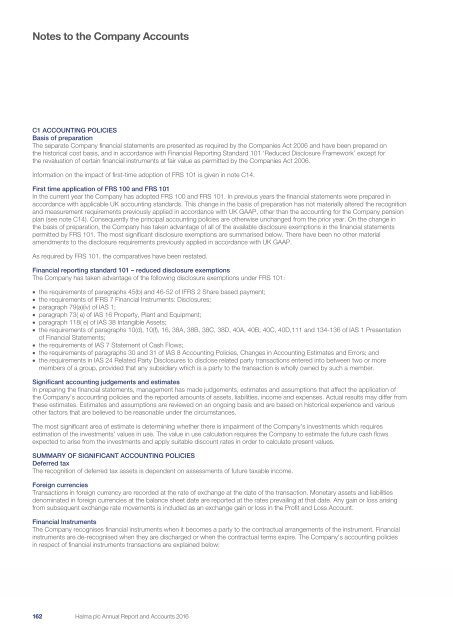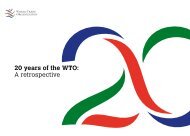You also want an ePaper? Increase the reach of your titles
YUMPU automatically turns print PDFs into web optimized ePapers that Google loves.
Notes to the Company Accounts<br />
C1 ACCOUNTING POLICIES<br />
Basis of preparation<br />
The separate Company financial statements are presented as required by the Companies Act 2006 and have been prepared on<br />
the historical cost basis, and in accordance with Financial Reporting Standard 101 ‘Reduced Disclosure Framework’ except for<br />
the revaluation of certain financial instruments at fair value as permitted by the Companies Act 2006.<br />
Information on the impact of first-time adoption of FRS 101 is given in note C14.<br />
First time application of FRS 100 and FRS 101<br />
In the current year the Company has adopted FRS 100 and FRS 101. In previous years the financial statements were prepared in<br />
accordance with applicable UK accounting standards. This change in the basis of preparation has not materially altered the recognition<br />
and measurement requirements previously applied in accordance with UK GAAP, other than the accounting for the Company pension<br />
plan (see note C14). Consequently the principal accounting policies are otherwise unchanged from the prior year. On the change in<br />
the basis of preparation, the Company has taken advantage of all of the available disclosure exemptions in the financial statements<br />
permitted by FRS 101. The most significant disclosure exemptions are summarised below. There have been no other material<br />
amendments to the disclosure requirements previously applied in accordance with UK GAAP.<br />
As required by FRS 101, the comparatives have been restated.<br />
Financial reporting standard 101 – reduced disclosure exemptions<br />
The Company has taken advantage of the following disclosure exemptions under FRS 101:<br />
the requirements of paragraphs 45(b) and 46-52 of IFRS 2 Share based payment;<br />
the requirements of IFRS 7 Financial Instruments: Disclosures;<br />
paragraph 79(a)(iv) of IAS 1;<br />
paragraph 73( e) of IAS 16 Property, Plant and Equipment;<br />
paragraph 118( e) of IAS 38 Intangible Assets;<br />
the requirements of paragraphs 10(d), 10(f), 16, 38A, 38B, 38C, 38D, 40A, 40B, 40C, 40D,111 and 134-136 of IAS 1 Presentation<br />
of Financial Statements;<br />
the requirements of IAS 7 Statement of Cash Flows;<br />
the requirements of paragraphs 30 and 31 of IAS 8 Accounting Policies, Changes in Accounting Estimates and Errors; and<br />
the requirements in IAS 24 Related Party Disclosures to disclose related party transactions entered into between two or more<br />
members of a group, provided that any subsidiary which is a party to the transaction is wholly owned by such a member.<br />
Significant accounting judgements and estimates<br />
In preparing the financial statements, management has made judgements, estimates and assumptions that affect the application of<br />
the Company’s accounting policies and the reported amounts of assets, liabilities, income and expenses. Actual results may differ from<br />
these estimates. Estimates and assumptions are reviewed on an ongoing basis and are based on historical experience and various<br />
other factors that are believed to be reasonable under the circumstances.<br />
The most significant area of estimate is determining whether there is impairment of the Company’s investments which requires<br />
estimation of the investments’ values in use. The value in use calculation requires the Company to estimate the future cash flows<br />
expected to arise from the investments and apply suitable discount rates in order to calculate present values.<br />
SUMMARY OF SIGNIFICANT ACCOUNTING POLICIES<br />
Deferred tax<br />
The recognition of deferred tax assets is dependent on assessments of future taxable income.<br />
Foreign currencies<br />
Transactions in foreign currency are recorded at the rate of exchange at the date of the transaction. Monetary assets and liabilities<br />
denominated in foreign currencies at the balance sheet date are reported at the rates prevailing at that date. Any gain or loss arising<br />
from subsequent exchange rate movements is included as an exchange gain or loss in the Profit and Loss Account.<br />
Financial Instruments<br />
The Company recognises financial instruments when it becomes a party to the contractual arrangements of the instrument. Financial<br />
instruments are de-recognised when they are discharged or when the contractual terms expire. The Company's accounting policies<br />
in respect of financial instruments transactions are explained below:<br />
162 160<br />
<strong>Halma</strong> plc Annual Report and Accounts <strong>2016</strong>

















